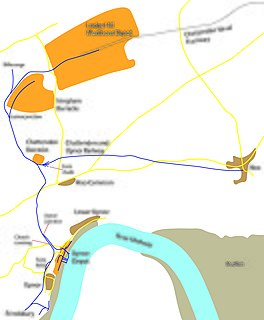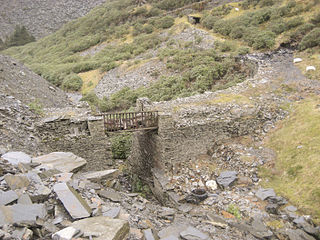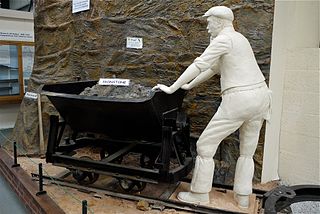
A narrow-gauge railway is a railway with a track gauge narrower than standard 1,435 mm. Most narrow-gauge railways are between 600 mm and 1,067 mm.

OO9, often also denoted as 009 or 00-9 is a model railway scale and gauge combination of 4 mm scale and 9 mm gauge tracks, which models a prototype track gauge of 2 ft 3 in. It is a common choice in the United Kingdom for the modelling of narrow-gauge railways whose prototype gauges lie approximately between 2 ft and 2 ft 6 in. The 9 mm track gauge is used by N gauge model railways, a common commercial scale, which means that a selection of wheels, track, and mechanisms is readily available.

Minimum-gauge railways have a gauge of most commonly 15 in, 400 mm, 16 in, 18 in, 19 in, 500 mm or 20 in. The notion of minimum-gauge railways was originally developed by estate railways and the French company of Decauville for industrial railways, mining, and farming applications.

There were more than a thousand British narrow-gauge railways ranging from large, historically significant common carriers to small, short-lived industrial railways. Many notable events in British railway history happened on narrow-gauge railways including the first use of steam locomotives, the first public railway and the first preserved railway.

Light Railways is a magazine produced by the Light Railway Research Society of Australia (LRRSA). The subtitle is "Australia's Magazine of Industrial and Narrow Gauge Railways".

On30gauge is the modelling of narrow gauge railways in O scale on HO gauge track in 1:48 scale ratio by American and Australian model railroaders, in 1:43.5 scale ratio by British and French model railroaders and 1:45 by Continental European model railroaders.

O14 is a set of model railway standards for accurately modelling 2 ft narrow-gauge railways in 1:43.5 using 14 mm (0.551 in) gauge track.
British industrial narrow-gauge railways are narrow-gauge railways in the United Kingdom and the Isle of Man that were primarily built to serve one or more industries. Some offered passenger services for employees or workmen, but they did not run public passenger trains. They are categorized by the primary industry they served.

The Cadeby Light Railway was a 2 ft narrow-gauge railway in the garden of the rectory in Cadeby, Leicestershire.

The Chattenden and Upnor Railway was a narrow gauge railway serving the military barracks and depot at Upnor, Kent and associated munitions and training depots. It was preceded in the early 1870s by a temporary standard-gauge railway. The 2 ft 6 in narrow gauge was built in 1885, and continued in use until the end of 1961.

The Colne Valley Waterworks railway was a 2 ft narrow gauge industrial railway connecting the London, Midland and Scottish Railway (LMS) Watford to Rickmansworth branch line with the Eastbury Pumping Station.

The Penrhyn Castle Railway Museum is a museum of industrial railway equipment, located at Penrhyn Castle near Bangor in Wales.

Egger-Bahn was a German model railway manufacturer. The company produced the first H0e models, and established HOe as a viable model railway standard. The firm was founded in 1963 by three brothers. One of them, a performer, soon left the firm. Theodor Egger, technician, and Jonathan Egger, salesman, continued. The models first appeared at the 1963 Nuremberg Toy Fair.

Some industrial narrow-gauge railways in the United Kingdom and the Isle of Man were primarily built to serve quarrying, mining, and similar industries. Some of these narrow-gauge railways offered passenger services for employees or workmen, but they did not run public passenger trains. They are listed by the primary industry they served.

Garndolbenmaen, known colloquially as Garn, is a village in the county of Gwynedd, Wales. It lies near the A487, approximately 6 miles (10 km) north west of Porthmadog, in the community of Dolbenmaen, which has a population of 1,300. The closest villages are Dolbenmaen and Bryncir. The Papur Bro, the local Welsh language paper, is called Y Ffynnon . The village itself has a population of around 300.

The South African Railways Class NG4 4-6-2T of 1911 was a narrow-gauge steam locomotive from the pre-Union era in the Colony of Natal.

The Irchester Narrow Gauge Railway Museum is a small railway museum and metre gauge railway near Irchester, in the Wellingborough district of Northamptonshire, England.
White River Productions is an independent publishing company that specializes in books and magazines targeted to railroad enthusiasts and historians. Kevin EuDaly founded the company in 1992 to published the book Missouri Pacific Diesel Power, which he also authored. Several other titles followed, and the company became his full-time venture beginning in 1996. The company expanded when it took on publishing newsletters and managing membership databases for several railroad historical societies. The company is headquartered in Bucklin, Missouri.

Solan railway station is a small railway station in Solan district in the Indian state of Himachal Pradesh. The station lies on UNESCO World Heritage Site Kalka–Shimla Railway. Solan railway station is located at an altitude of 1,502 metres (4,928 ft) above mean sea level. It was allotted the railway code of SOL under the jurisdiction of Ambala railway division. The 610 mm -wide narrow-gauge Kalka–Shimla Railway was constructed by Delhi–Ambala–Kalka Railway Company and opened for traffic in 1903. In 1905 the line was regauged to 762 mm -wide narrow gauge.

















